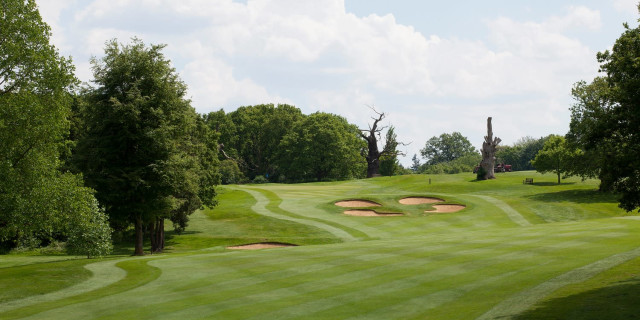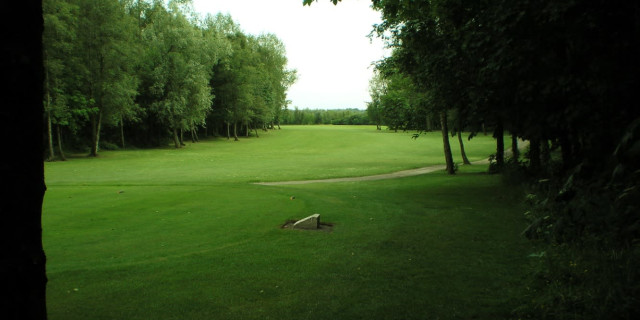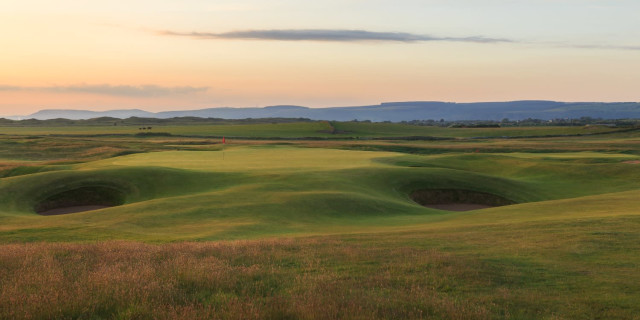
Golf in Kent Travel Trip
Article by Golfshake Ambassador Andrew Picken
It’s a dirty job, but someone has to do it. The editor asked if I could spare a week to visit and play assorted courses in the Kent area. I have to admit that I had never visited the area other than passing through to get to Dover. I knew of its beauty and reputation as the Garden of England but was not really aware of its significance as a golf destination. If I accepted the mission we would arrange our own accommodation using some of the myriad pubs and coaching inns that litter the county. Golf and coaching inns? What’s not to like about that.
I started my accommodation research having been given a list of courses that we were to play. The trip was crammed with most days playing at least 36 holes. This research led to some difficulties as I was totally spoilt for choice.
Golfbreaks.com offer a number of package deals that include accommodation with the golf but also check out the individual clubs web sites as most also include local recommendations for the best golf friendly locations.
Another very useful resource was www.golfinkent.co.uk. This is a one stop shop for all your golfing needs when arranging a trip to this area. It contains information about where to stay and eat and also provides information specific to geographical areas. This is very useful when planning golf tours. It also gives information about the variety of other activities available in this region such as walking, historic and heritage tours, and even adrenalin adventures.
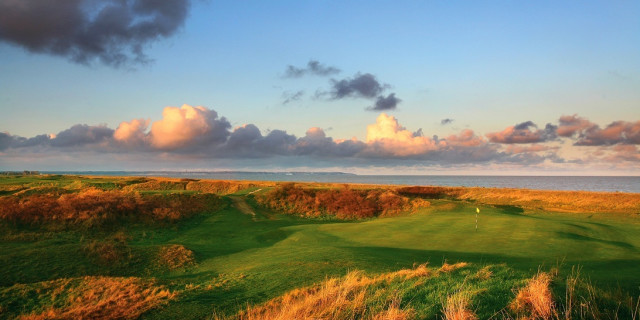
We decided to try and base ourselves at one central location and then travel out daily to our respective courses.
This proved to be an inspired choice as we found a delightful pub called the Five Bells located in the heart of a quaint village called Eastry. Great accommodation, linked to fabulous home -made food. The Pub was friendly and even had its own golf society including Honours Board. We played Petanque and Darts and became part of the regular set of customers who knew each other by first names. I love this kind of pub and I would recommend it without reservation to any visiting golfers. http://www.thefivebellseastry.com. This has been an Inn since 1675. Part of the pub utilises the old Fire Station as an additional function room.
The more I researched, the trip the more intrigued I became. Why was this area such a hot bed for tourism? I checked out a number of the centenary books written to celebrate the courses I was to visit and together with an excellent publication called Golf on the Kent Coast by David L Dobby published in 1993 began to understand a little more as to why this area became the golfing hotbed that it is today.
My list of courses included the following:
London Golf Club
Royal Cinque Ports Golf Club
North Foreland Golf Club
Littlestone Golf Club
Royal St. George’s Golf Club
Leeds Castle Golf Club
Hever Castle Golf Club
This was a brilliant eclectic mix of some superb golf clubs including Open Championships venues.
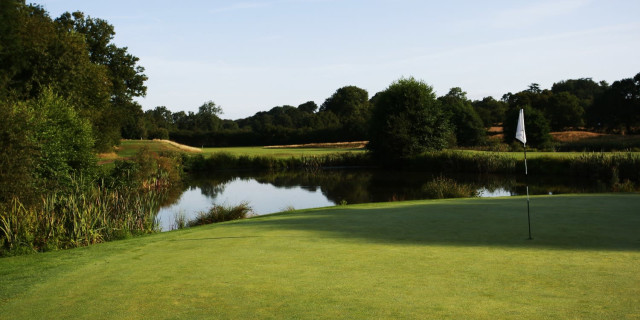
Why has this area developed into such a gol hot spot?
My research led me to link the growth of the courses directly to the development and influence of the railway system. Golf was primarily a sport for the leisure classes and they began to acquire coastal properties that could be reached easily by train from the main urban centres such as London.
Historically,one of the reasons for the number of Castles and heritage properties in this region was the fact that most could be reached within a day of horse riding from London by the nobility and the same principles applied when the trains became more popular.
Many of the golf courses were serviced directly by stations and certain train lines were developed purely for the use of the travelling golfer. There was fierce competition between rival train companies with some duplication of routes that led to their eventual demise.
Potted History of Royal St George's Golf Club
It appears that when Royal St George's was conceived it was done so as an extension of a London club with its green by the seaside. It was formed by Dr Laidlaw Purves, a Scottish member of the Royal Wimbledon Golf Club and a member of the Honourable Company of Edinburgh Golfers. They wished to provide links golf without the need to travel to Hoylake or Muirfield. His brother was heavily involved in Gullane Golf Club. Initially all club meetings for RSG where held in London until the turn of the century. After the death of the first secretary W R Rutherford, a barrister, a local secretary was engaged who lived in Sandwich.
Travel to this area was primarily by train and extra carriages were laid on for use on Friday afternoons to accommodate the golfers from London stations. A tram link was established in 1900 providing a door to door service to the club.
The development of courses in this area coincided with the advent of the Haskell rubber cored ball in 1898. A year later the golf tee was patented and the British PGA was formed in 1901. Until the 1880s golf was mainly a Scottish past time with approx 50 courses in England and few others anywhere else in the world. This was clearly a golden period of golf course development.
In 1902 it was awarded its royal accolade by King Edward VII and in 1927 the Prince of Wales became the Club Captain.
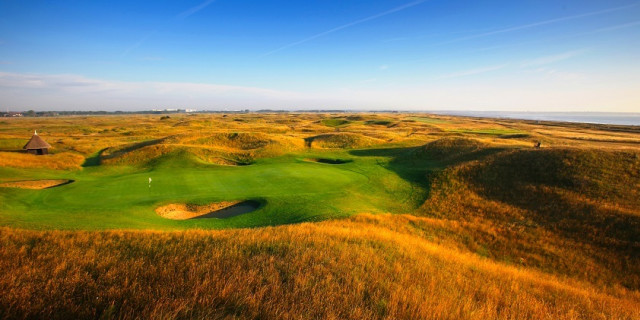
The course was designed by Ramsey Hunter. He was head green keeper, caddie master and club maker. He eventually left to become the professional at Chicago Golf Club. In 1911, Fred Whiting became the professional beginning a family association that lasted 78 years as he passed on the role to his son Albert who in turn did the same for his son Cyril. The Whiting family are amazing. Around the turn of the century there were eight brothers. Seven became club professionals. The second generation produced a further eight professionals who travelled the world in particular the USA.
Royal St George's further influenced the global game when it became the first Open championship venue outside of Scotland in 1894. The Open has been held there 14 times since. It has established itself as one of the world’s greatest golf courses. It used a flag and mast system which was a useful tool for the visiting golfer. Many stayed at the nearby the Guilford Hotel in Sandwich Bay or the Bell in Sandwich. The flag pole and mast could be seen from these locations. A red club flag meant that play was restricted to club members only and advised the travelling golfer to travel to Princes or Deal instead. A white flag signified a major club event.
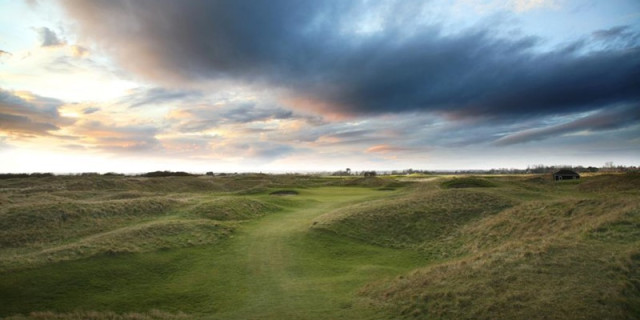
My research indicated that Dr Purves was also involved in discovering the site for Littlestone Golf Club and then redesigning its layout.
In its early days it was mainly for Londoners and was a stronghold for parliamentarians and members of the Bar. Strangely, the Club Captain at one point was Prime Minister Asquith and he was supported by his Club President A J Balfour who was the leader of the opposition parties. What an amazing coalition!
This course was redesigned in the 1920s by one of my favourite golf architects Dr Alister MacKenzie. He adapted changes instigated on the advice of James Braid in 1909. In 1905, 90% of its membership of 612 were London based professionals.
What other interests can be pursued in Kent?
1. Heritage - Kent is the oldest county in England
Canterbury is among the oldest cities with a continuous history – trace its rich heritage through the architectural styles of buildings along its narrow cobbled streets and visit St Martin’s, part of the Canterbury World Heritage Site, the oldest working parish church in England. Wander the atmospheric streets of Sandwich and you’ll come across the highest density of listed buildings of any town in England, Sandwich also has more medieval buildings than anywhere else.
2. Cathedrals - Kent is home to the two oldest Cathedrals in England
As soon as you step into the magnificent interior of Canterbury Cathedral you can sense the deep stirrings of history and worship stretching right back to AD 597. The Mother Church of the Anglican Communion has a rich tradition of welcoming visitors, ever since medieval pilgrims were drawn to the spot where in 1170 Thomas Becket was murdered. Rochester Cathedral, founded in AD 604, is the second oldest cathedral in England. The Cathedral recently unveiled the first real fresco to be painted in an English cathedral for nearly 800 years
3. Castles - Kent has more castles and historic houses than any other county
Dover Castle, commanding the shortest sea crossing to the Continent, has been known for centuries as the Key to England. At Dover you can experience life from Roman times to World War II, while the Secret Wartime Tunnels include the only underground barracks ever built in Britain. Hever Castle, the childhood home of Anne Boleyn, echoes with romance – not least from the time Henry VIII came a-wooing his second wife. Other castles in include Walmer Castle, Deal Castle, Leeds Castle, Rochester Castle and Upnor Castle.
4. Gardens - Kent is the Garden of England and its gardens are world renowned.
With 180-plus to choose from, there’s one to match your every mood. Explore one of the world’s most celebrated 20th-century gardens at Sissinghurst, the spellbinding creation of writer/poet Vita Sackville-West and her husband, diplomat/writer Harold Nicolson. Scotney Castle Garden is pure fairytale! Created in the 1830s by Edward Hussey, in ‘Picturesque’ style around the ruins of a small 14th-century moated castle. Emmetts Garden is relaxed and informal, with many rare trees and shrubs from across the world. You’ll also find the highest treetop in Kent here!
5. Coast - Tour the Kent coast, following The Maritime Heritage Trail
Whether you’re after traditional family entertainment, adrenaline watersports or somewhere to chill out, Kent’s varied coastline has just the beach or resort for you. Head for the captivating sandy bays of Broadstairs, Charles Dickens’ favourite holiday resort, wind down, have bucket-and-spade fun, flex your limbs pursuing water sports. Joss Bay is popular with the surfing fraternity, while the safe, secluded environment of Viking Bay is perfect for families and swimming. Whitstable and Herne Bay, nestling on the north Kent coast, also have distinctive characters.
6. Maritime Heritage
The most complete dockyard of the Age of Sail, The Historic Dockyard Chatham, spans over 400 years of maritime history and was the place where the ships that defeated the Spanish Armada and Napoleon’s forces were built. The intriguing remains of the world’s oldest known seagoing boat are on show at Dover Museum. Visit Ramsgate, the country’s only Royal Harbour, a title it earned from King George IV and look out for the full-size replica Viking Ship at Pegwell Bay, commemorating the arrival of Hengist and Horsa in AD 449. Richborough was the main entry port for legions invading in AD 43 and you can relive the early stages of conquest amid the evocative ruins of Richborough Roman Fort. The ‘Iron’ Duke of Wellington was once Lord Warden of the Cinque Ports, which granted him residence at Walmer Castle. You can still see his original Wellington Boots there
7. The White Cliffs of Dover
Amazing but true: it took 80 million years to form the White Cliffs of Dover from the crushed remains of billions of tiny sea-dwelling plants and animals. The area now provides the habitat for many species of flora and fauna, including some that are rare, and it has been designated a Site of Special Scientific Interest. Bring your binoculars, your camera and limitless curiosity. With a visitor centre, shop and café, the White Cliffs make a fabulous family day out.
8. Countryside - Some 6,876 km of footpaths criss-cross the Kent countryside
Walk, wildlife-spot or just relax in a wonderful Kent Downs Area of Outstanding Natural Beauty. The eastern half of the North Downs is known as the Kent Downs and they stretch 878 sq km (339 sq miles) across nearly a quarter of the county, from the White Cliffs at Dover to the Surrey and London borders.
9. Food and wine - The Garden of England is renowned for its fruit production
Treat yourself to a genuine taste of Kent with a tour of award-winning Chapel Down Winery at Tenterden Vineyard, the country’s largest producer of English wines. Shepherd Neame is Britain’s oldest brewer and you’ll find its characterful pubs scattered throughout the county, where you can sip handcrafted ales full of spicy Kentish hops. Or go behind the scenes at its brewery in Faversham to discover the processes behind the making of the perfect tipple.
10. Famous connections, authors and artists
Follow the 17th-century Indian Princess Pocahontas to St George’s Church, Gravesend and Dickens to locations for Great Expectations and The Pickwick Papers in Rochester. Geoffrey Chaucer’s The Canterbury Tales was the first book to be printed in England, in 1476 and Jane Austen was a frequent visitor to Goodnestone Park Gardens, near Canterbury. The artist JMW Turner lived in Margate and claimed the area has ‘the loveliest skies in Europe’. Surprisingly for such a tranquil county, you’ll also uncover the source of all-action tales and sinister goings-on. Have a drink in The Duck Inn at Pett Bottom where – You Only Live Twice – 007’s adventures took shape, or dare to enter Arthur Conan Doyle’s Valley of Fear!
Royal St George's was disguised in another of Ian Fleming’s books when he described the match between Goldfinger and James Bond being played at Royal St Marks. He was thought to have been a member of the golf club.
To find out more about Kent’s unique highlights and attractions, see www.visitkent.co.uk.
Related Content: Kent

